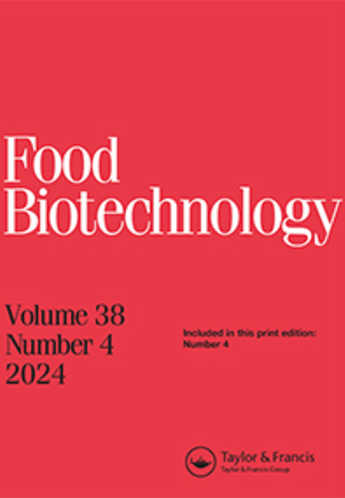Isolation and characterization of anti-inflammatory peptides derived from trypsin hydrolysis of microalgae protein (Synechococcus sp. VDW)
IF 1.6
4区 农林科学
Q4 BIOTECHNOLOGY & APPLIED MICROBIOLOGY
引用次数: 24
Abstract
ABSTRACT The Synechococcus sp. VDW peptides were prepared by trypsin digestion, which was then purified by ultrafiltration with molecular weight cut off membranes of 10, 5 and 3 kDa. Among the fractions, the MW <3 kDa fraction exhibited high levels of inhibitory activity toward the NO radical scavenging activities with IC50 values of 34.51 ± 9.8 μg/mL. The MW <3 kDa fraction was purified by reversed-phase HPLC to yield four fractions. The 30–40 min sub-fraction with maximum NO radical scavenging activity (77.50 ± 0.55%) was selected for further analysis by Q-TOF ESI mass spectrometry. Five isolated peptides with amino acid sequences of AILQSYSAGKTK; 1,265.69 Da, ALNKTHLIQTK; 1,265.74 Da, LLVHAPVK; 875.55 Da, IPDAHPVK; 875.48 Da, and VVVLRDGAVQQLGTPR; 1,706.97 Da were identified. The MW <3 kDa fraction showed no cytotoxicity toward RAW264.7 macrophage cells. Quantitative RT-PCR results showed that the MW <3 kDa fraction reduced gene expression of pro-inflammatory cytokines iNOS, TNF-α, COX-2, and IL-6. The peptides isolated from the MW <3 kDa fractions represent potential model peptides to develop natural anti-inflammation food-grade ingredients, drugs, and cosmetic products.微藻蛋白(Synechococcus sp. VDW)胰蛋白酶水解产物抗炎肽的分离与鉴定
摘要:采用胰蛋白酶酶切法制备聚珠球菌VDW多肽,并采用分子量分别为10、5和3 kDa的超滤分离纯化。其中,MW <3 kDa部位对NO自由基的清除活性具有较高的抑制作用,IC50值为34.51±9.8 μg/mL。用反相高效液相色谱法纯化分子量<3 kDa的部分,得到4个部分。选取清除NO自由基活性最高(77.50±0.55%)的30-40 min亚段,采用Q-TOF ESI质谱法进行进一步分析。AILQSYSAGKTK氨基酸序列的5个分离肽段;1,265.69 Da, ALNKTHLIQTK;1,265.74 Da, LLVHAPVK;875.55 Da, IPDAHPVK;875.48 Da,和VVVLRDGAVQQLGTPR;鉴定出1,706.97个Da。MW <3 kDa部分对RAW264.7巨噬细胞无细胞毒性。定量RT-PCR结果显示,MW < 3kda组分降低了促炎细胞因子iNOS、TNF-α、COX-2和IL-6的基因表达。从分子量<3 kDa组分中分离的肽代表了开发天然抗炎症食品级成分、药物和化妆品的潜在模型肽。
本文章由计算机程序翻译,如有差异,请以英文原文为准。
求助全文
约1分钟内获得全文
求助全文
来源期刊

Food Biotechnology
工程技术-生物工程与应用微生物
CiteScore
3.80
自引率
0.00%
发文量
15
审稿时长
>12 weeks
期刊介绍:
Food Biotechnology is an international, peer-reviewed journal that is focused on current and emerging developments and applications of modern genetics, enzymatic, metabolic and systems-based biochemical processes in food and food-related biological systems. The goal is to help produce and improve foods, food ingredients, and functional foods at the processing stage and beyond agricultural production.
Other areas of strong interest are microbial and fermentation-based metabolic processing to improve foods, food microbiomes for health, metabolic basis for food ingredients with health benefits, molecular and metabolic approaches to functional foods, and biochemical processes for food waste remediation. In addition, articles addressing the topics of modern molecular, metabolic and biochemical approaches to improving food safety and quality are also published.
Researchers in agriculture, food science and nutrition, including food and biotechnology consultants around the world will benefit from the research published in Food Biotechnology. The published research and reviews can be utilized to further educational and research programs and may also be applied to food quality and value added processing challenges, which are continuously evolving and expanding based upon the peer reviewed research conducted and published in the journal.
 求助内容:
求助内容: 应助结果提醒方式:
应助结果提醒方式:


